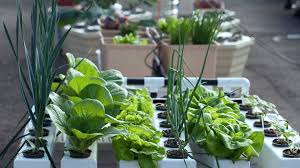Redefining Farming Efficiency: Hydroponic Supplies Leading the Way
The global agricultural landscape is undergoing a profound transformation, driven by the need for more sustainable and efficient food production methods. In this era of changing climate patterns, resource scarcity, and a growing global population, traditional farming practices are facing challenges that demand innovative solutions. Hydroponic Global , coupled with advanced hydroponic supplies, has emerged as a groundbreaking approach to redefine farming efficiency and ensure a consistent supply of fresh, high-quality produce.
Hydroponics: A New Paradigm in Agriculture
Hydroponics represents a departure from conventional soil-based agriculture by cultivating plants without soil and instead using nutrient-rich water solutions.

This method not only optimizes resource utilization but also mitigates issues related to soil erosion, excessive water consumption, and the use of synthetic fertilizers. By creating controlled environments that can be adapted to different crops and climates, hydroponics offers the potential for year-round cultivation regardless of external conditions.
The Role of Hydroponic Supplies
Central to the success of hydroponics are the specialized supplies that support this innovative agricultural method. These supplies are designed to maximize plant growth, optimize nutrient delivery, and streamline maintenance. Key hydroponic supplies driving farming efficiency include:
- Growing Systems: Hydroponic systems come in various designs, each tailored to specific plant types and growth stages. Nutrient Film Technique (NFT), Deep Water Culture (DWC), and Vertical Farming systems are examples of setups that maximize space and resource utilization.
- Nutrient Solutions: Hydroponic farming relies on nutrient solutions that provide plants with precisely balanced essential nutrients. These solutions are customizable to cater to the unique requirements of different crops, resulting in healthier and more productive plants.
- Grow Mediums: While hydroponics eliminates the need for soil, plants still require a stable medium to anchor their roots. Common mediums include coconut coir, perlite, and rockwool, each contributing to optimal root aeration and nutrient absorption.
- Advanced Monitoring and Control Systems: Technology-driven monitoring and control systems allow farmers to remotely manage environmental factors such as temperature, humidity, light intensity, and nutrient levels. This precision ensures optimal conditions for growth and minimizes resource waste.
- LED Grow Lights: In indoor or vertical hydroponic setups, LED grow lights simulate sunlight, providing the necessary light spectrum for photosynthesis. LED technology offers energy efficiency, long lifespans, and the ability to tailor light wavelengths to specific growth stages.
Revolutionizing Efficiency in Agriculture
Hydroponic supplies are at the forefront of redefining farming efficiency by addressing several critical challenges:
- Resource Efficiency: Hydroponics reduces water consumption by up to 90% compared to traditional agriculture. Nutrient recycling and precise nutrient delivery further optimize resource utilization.
- Space Utilization: Vertical hydroponic systems enable farmers to maximize land use, making it feasible to cultivate crops in urban areas and areas with limited arable land.
- Climate Resilience: Controlled environments shield crops from adverse weather conditions, ensuring stable production regardless of external climate fluctuations.
- Reduced Chemical Dependency: Hydroponics minimizes the need for synthetic pesticides and fertilizers, leading to cleaner, safer produce and healthier ecosystems.
Future Prospects and Challenges
As hydroponic technology advances and becomes more accessible, its potential impact on global agriculture is significant. However, challenges remain, including the initial setup costs, energy requirements, and the need for specialized knowledge. Addressing these challenges through research, innovation, and education will be crucial for mainstream adoption.
Hydroponic supplies are leading the way in redefining farming efficiency. This innovative approach holds the promise of sustainable and consistent food production, capable of feeding a growing population while mitigating environmental impacts. As hydroponics continues to evolve and gain momentum, it has the potential to reshape the agricultural landscape, providing a blueprint for a more resilient and efficient future in food production.